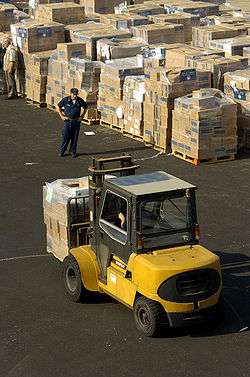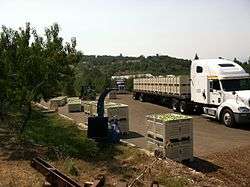LDS Humanitarian Services

LDS Humanitarian Services is a branch of the Welfare Services department of The Church of Jesus Christ of Latter-day Saints (LDS Church). The organization’s stated mission is to relieve suffering, to foster self-reliance for people of all nationalities and religions, and to provide opportunities for service.[1]
Overview
The LDS Church considers humanitarian work to be an essential part of its mission to bless all humanity in emulation of Jesus Christ “who went about doing good, and healing all that were oppressed” (Acts 10:38). Throughout its history, the LDS Church has always provided for those in need and is perhaps best known for its efforts to take care of its own. In 1842, Joseph Smith, founder of the Latter Day Saint movement, organized the Women’s Relief Society, with a primary focus to provide “relief” to suffering members and ultimately to all people. During the Great Depression the LDS Church organized a welfare program, now administered the church's Welfare Services department, to help provide for the needs of its members.
As the program has grown, the church's welfare efforts have expanded to help people around the world regardless of religion, race, or nationality. LDS Humanitarian Services was created to coordinate these efforts in partnership with government and other nonprofit agencies around the world. The church's humanitarian work primarily helps those in need who are not members of the church. There are many people in virtually any community in the world who struggle to have basic needs met. The church seeks to help as many as possible.[2] Key humanitarian initiatives include clean water, vision treatment, wheelchair provision, neonatal resuscitation, and disaster relief. Other initiatives include immunizations, family enrichment programs, and family food production. In 2008, LDS Humanitarian Services provided aid to 3.3 million people in 122 countries, and since 1985 help has been given to 23 million people in 163 nations. All of these initiatives, as well as support and advice on personal and community preparation for disasters can be found on the LDS Church’s Provident Living website.
The funding for LDS Humanitarian Services comes from philanthropic support of the church’s members and other donors. Donations to the Humanitarian Fund are collected through local bishops and through LDS Philanthropies.
LDS humanitarian initiatives

- Emergency Response is the part of the LDS Church’s humanitarian efforts of which most people are aware. Funds and supplies in this area are used to help victims of natural disasters such as earthquakes, floods, droughts, tornadoes, and hurricanes, as well as other disasters such as wars or political unrest. Supplies in this area are gathered and stored before a crisis so supplies can be sent within hours of an emergency. Volunteers are also on call so they can be reached and organized within a few hours, if needed. The LDS Church is renowned for its ability to organize its members in various regions of the world to respond to emergency and facilitate distributing goods immediately after a crisis, often before aid programs such as the Red Cross or the Salvation Army come to assist. In 2008, the LDS Church responded to 124 disasters in 48 countries.[3]
- Wheelchair Distribution is another church program crucial to helping those in need. Studies estimate that only one percent of the disabled in the world have wheelchairs. For the rest, being without a wheelchair means adults can not provide for themselves or their families, and for children it often means not being able to attend school. By providing wheelchairs to those in need, the church hopes to help people become more self-reliant which is an important tenant of LDS beliefs.[4]
- The Clean Water Service provides clean water and wells to people who otherwise would most likely contract deadly diseases because of the dirty water. It is estimated that one billion people lack clean water. The clean water program is designed to partner with local community agencies to provide sustainable clean water.[5]
- The Neonatal Resuscitation program sends doctors and volunteers to areas where infant mortality rate is high. They are able to teach people in the area how to resuscitate newborns as well as provide simple medical equipment. This service is greatly needed as it is estimated that nearly 1 million newborns die each year due to birth difficulties. Up to 10% of newborns have breathing difficulties.[6]
- The Vision Treatment Training program teaches facilities and medical personnel in developing countries how to treat preventable or reversible blindness. There are 37 million people in the world who are blind, and up to 75 % of blindness is treatable. The vision care program works with local vision health care centers to help treat and prevent blindness for the poor.[7]
In addition to these efforts, the LDS Church also has over 300 job development and placement centers around the world. In 2001, the church began the Perpetual Education Fund which provides money to cover tuition and other school expenses to people in developing nations. As of 2007, tens of thousands of individuals had been given assistance. So far this program has operated primarily in South America and Oceana. The LDS Church has also begun producing a nutrition-rich porridge named Atmit to help during acute famines. The church welfare program owns farms, ranches, canneries, and other food producing facilities to provide temporary food relief for families and individuals. LDS Humanitarian Services frequently works with other charities and NGOs such as the Red Cross, Catholic charities and even various Islamic charities for which the LDS Church has produced halaal food.[8]
Sources and funds for humanitarian work
All of these initiatives require manpower and while there are some full-time employees in administrative and clerical functions, there are also thousands of volunteer humanitarian missionaries. In emergency situations, local members and full-time missionaries who would normally devote their time to proselyting will participate in relief efforts, but in many of these more permanent initiatives the LDS Church uses senior-aged missionary couples.
These couples are retired church members who devote six months to two years of their time to go anywhere in the world, typically at their own expense, to participate in these projects. Because of this volunteer force, the church is able to use 100 percent of money and goods donated in helping those in need. These missionaries often serve in activities related to their former profession. Doctors and nurses will serve medical missions either in the Neonatal Resuscitation programs or special missions to countries in need of dentists, eye doctors, surgeons and so forth. People with agricultural or engineering backgrounds will serve on the clean water initiative or else help farmers in developing countries.
Other members who are still working and raising families frequently donate time, money, and in-kind donations to help in these ventures. Members can volunteer at local canneries and farms to help produce food for the needy. They can volunteer to create the medical kits needed for doctors and new mothers in developing nations and many help make blankets for needy families. Many of these local initiatives are organized by the Relief Society. This volunteer force allows the LDS Church to reduce operating expenses and serve more people with their resources.
From 1985 - 2009, $327.6 million in cash and $884.6 million in commodities of aid was given throughout 178 countries.[9]
See also
References
- ↑ Humanitarian Services Operations Guide
- ↑ https://www.lds.org/topics/humanitarian-service/church?lang=eng
- ↑ "Emergency Response". Retrieved 2009-07-14.
- ↑ "Wheelchair Distribution". Retrieved 2009-07-14.
- ↑ "Clean Water". Retrieved 2009-07-14.
- ↑ "Neonatal Resuscitation". Retrieved 2010-10-11.
- ↑ "Vision Treatment". Retrieved 2009-07-14.
- ↑ "Provident Living Home". Retrieved 2007-12-30.
- ↑ "Welfare Services Fact Sheet - 2009" (PDF). Retrieved 2011-07-09.
- Employment Resource Services – 2009 Fact Sheet
- Humanitarian Services Operation Guide – Part A
External links
| Wikimedia Commons has media related to LDS Humanitarian Services. |
- LDS Charities. The new website for LDS Charities.
- LDS Humanitarian Services. The official website for LDS Humanitarian Services.
- LDS Philanthropies. The official website for the LDS Church's fundraising arm.
- Provident Living, the LDS Church's website devoted to helping people become self-sufficient.